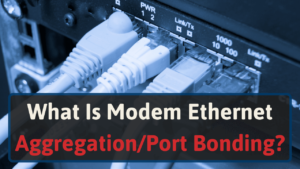Hi, I’m Jon, a home networking enthusiast, and engineer. I’ve had the chance to use several modems with port bonding/Ethernet aggregation.
So I made this guide to help explain what it is, how it works, and its benefits.
Keep reading to learn more about port bonding.
Key Takeaways
- Modem port bonding lets combine 2 Ethernet cables into one to get faster speeds (up to 2000 Mbps)
- Modems with port bonding are only necessary for Internet plans between 1000-2000 Mbps
- The problem with port bonding is that you need an extra IP (contact your ISP for more info) and a router that supports it
- A modem with a single 2.5 Gbps port is a good alternative to modems with port bonding
Port Aggregation Explained
Port aggregation enables your devices to use and treat multiple Ethernet links as though they were a single link. By “combining” links, you utilize the power of both network connections.
This enables you to increase network bandwidth and ensure network redundancy between devices should one link fail.
This means if you have a high-speed Internet plan, like 2,000 Mbps, you can get a modem with port bonding to access those speeds.
Both cable modems and routers can use a type of port aggregation:
- Local area network (LAN)
- Wide area network (WAN) [1]
Since each type is different, let’s take a look at them.
LAN Aggregation
LAN aggregation isn’t applicable to modems, but some network professionals use the terms “port bonding,” “Ethernet aggregation,” etc., interchangeably.
Local area network (LAN) aggregation is associated with devices connected to your home. In other words, network switches, network storage, etc., in your home that connect to your network.
Most homeowners will never use LAN aggregation. But it is a useful method to provide more bandwidth from your router to a network switch or a NAS (network-attached storage) system.
With LAN aggregation, homeowners should notice more throughput and bandwidth for each connected device. On top of that, LAN aggregation has network redundancy– if one connection fails, the other will still function.
WAN Aggregation
Wide area network (WAN) aggregation is a feature on cable modems. It combines two network connections from your modem to the router, with the capability of doubling your home’s bandwidth.
Homes that have access to ultra-fast cable Internet plans (2,000 Mbps) from their ISPs benefit the most from modems with WAN aggregation capabilities.
However, to combine the two Ethernet ports into one data stream at your modem, you will need two different IP addresses from your ISP. This means you might need to pay an extra fee– contact your ISP for details.
Additionally, you will need a router that supports port bonding. So, that’s another extra expense you will have to consider.
Do You Need A Modem With Port Bonding?
Whether you need a modem with port bonding or not depends entirely on your Internet plan.
If your ISP’s fastest Internet plan is 1000 Mbps or less, you can use a regular modem without port bonding.
I only recommend getting a modem with Ethernet aggregation if you meet one of the following:
- You have an Internet plan of of more than 1000 Mbps
- Your ISP will soon start offering a 1000+ Mbps plan and you plan to get it
- The ISP where you’re moving to has a 1000+ Mbps plan and you plan to get it
Otherwise, you would be spending extra money for a feature you likely will never use.
If you have an Internet plan of 2000 Mbps and getting a modem with port bonding, finding a compatible router, and getting two IP addresses sounds two complex, there is an alternative.
Instead, you can just get a modem with a single 2.5 Gbps Ethernet port. In this case, you won’t need two IP addresses nor a special router (but you’ll still want a router that is fast enough).
However, modems with a 2.5 Gbps port usually cost more than modems with port bonding.
FAQs
Here are some common questions about Ethernet aggregation.
Will a modem with Ethernet Aggregation make my Internet faster?
Although using a modem with Ethernet aggregation can make your Internet faster, it will never exceed the maximum speed your ISP offers.
If you have an Internet plan of 2,000 Mbps and currently use a modem with a maximum throughput of 1,000 Mbps, upgrading to a modem with Ethernet aggregation could make the Internet in your home faster.
That’s assuming you have a router that can handle that bandwidth too.
What Internet speed should I use with port bonding?
You really should only use a cable modem with port bonding if you have an Internet plan that is faster than 1000 Mbps. So in practice, 1200-2000 Mbps.
Final Thoughts
Port bonding (also known as Ethernet aggregation and link aggregation) is a method to combine two Ethernet connections into one to achieve more bandwidth on your home network.
You should use a cable modem with Ethernet aggregation if you have an Internet plan with max speeds of 1200 to 2000 Mbps.
Looking for the best modem for your Internet plan? Check out our approved modem guides for help.







